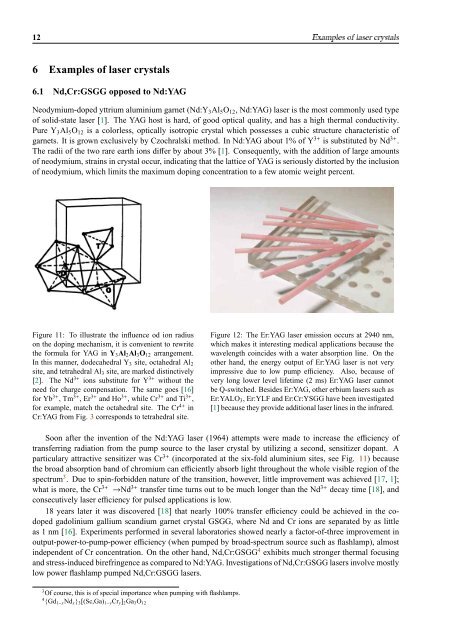moj seminar P ... - F9
moj seminar P ... - F9
moj seminar P ... - F9
You also want an ePaper? Increase the reach of your titles
YUMPU automatically turns print PDFs into web optimized ePapers that Google loves.
12 Examples of laser crystals6 Examples of laser crystals6.1 Nd,Cr:GSGG opposed to Nd:YAGNeodymium-doped yttrium aluminium garnet (Nd:Y 3 Al 5 O 12 , Nd:YAG) laser is the most commonly used typeof solid-state laser [1]. The YAG host is hard, of good optical quality, and has a high thermal conductivity.Pure Y 3 Al 5 O 12 is a colorless, optically isotropic crystal which possesses a cubic structure characteristic ofgarnets. It is grown exclusively by Czochralski method. In Nd:YAG about 1% of Y 3+ is substituted by Nd 3+ .The radii of the two rare earth ions differ by about 3% [1]. Consequently, with the addition of large amountsof neodymium, strains in crystal occur, indicating that the lattice of YAG is seriously distorted by the inclusionof neodymium, which limits the maximum doping concentration to a few atomic weight percent.Figure 11: To illustrate the influence od ion radiuson the doping mechanism, it is convenient to rewritethe formula for YAG in Y 3 Al 2 Al 3 O 12 arrangement.In this manner, dodecahedral Y 3 site, octahedral Al 2site, and tetrahedral Al 3 site, are marked distinctively[2]. The Nd 3+ ions substitute for Y 3+ without theneed for charge compensation. The same goes [16]for Yb 3+ , Tm 3+ , Er 3+ and Ho 3+ , while Cr 3+ and Ti 3+ ,for example, match the octahedral site. The Cr 4+ inCr:YAG from Fig. 3 corresponds to tetrahedral site.Figure 12: The Er:YAG laser emission occurs at 2940 nm,which makes it interesting medical applications because thewavelength coincides with a water absorption line. On theother hand, the energy output of Er:YAG laser is not veryimpressive due to low pump efficiency. Also, because ofvery long lower level lifetime (2 ms) Er:YAG laser cannotbe Q-switched. Besides Er:YAG, other erbium lasers such asEr:YALO 3 , Er:YLF and Er:Cr:YSGG have been investigated[1] because they provide additional laser lines in the infrared.Soon after the invention of the Nd:YAG laser (1964) attempts were made to increase the efficiency oftransferring radiation from the pump source to the laser crystal by utilizing a second, sensitizer dopant. Aparticulary attractive sensitizer was Cr 3+ (incorporated at the six-fold aluminium sites, see Fig. 11) becausethe broad absorption band of chromium can efficiently absorb light throughout the whole visible region of thespectrum 3 . Due to spin-forbidden nature of the transition, however, little improvement was achieved [17, 1];what is more, the Cr 3+ →Nd 3+ transfer time turns out to be much longer than the Nd 3+ decay time [18], andconsecutively laser efficiency for pulsed applications is low.18 years later it was discovered [18] that nearly 100% transfer efficiency could be achieved in the codopedgadolinium gallium scandium garnet crystal GSGG, where Nd and Cr ions are separated by as littleas 1 nm [16]. Experiments performed in several laboratories showed nearly a factor-of-three improvement inoutput-power-to-pump-power efficiency (when pumped by broad-spectrum source such as flashlamp), almostindependent of Cr concentration. On the other hand, Nd,Cr:GSGG 4 exhibits much stronger thermal focusingand stress-induced birefringence as compared to Nd:YAG. Investigations of Nd,Cr:GSGG lasers involve mostlylow power flashlamp pumped Nd,Cr:GSGG lasers.3 Of course, this is of special importance when pumping with flashlamps.4 {Gd 1−x Nd x } 3 [(Sc,Ga) 1−y Cr y ] 2 Ga 3 O 12















